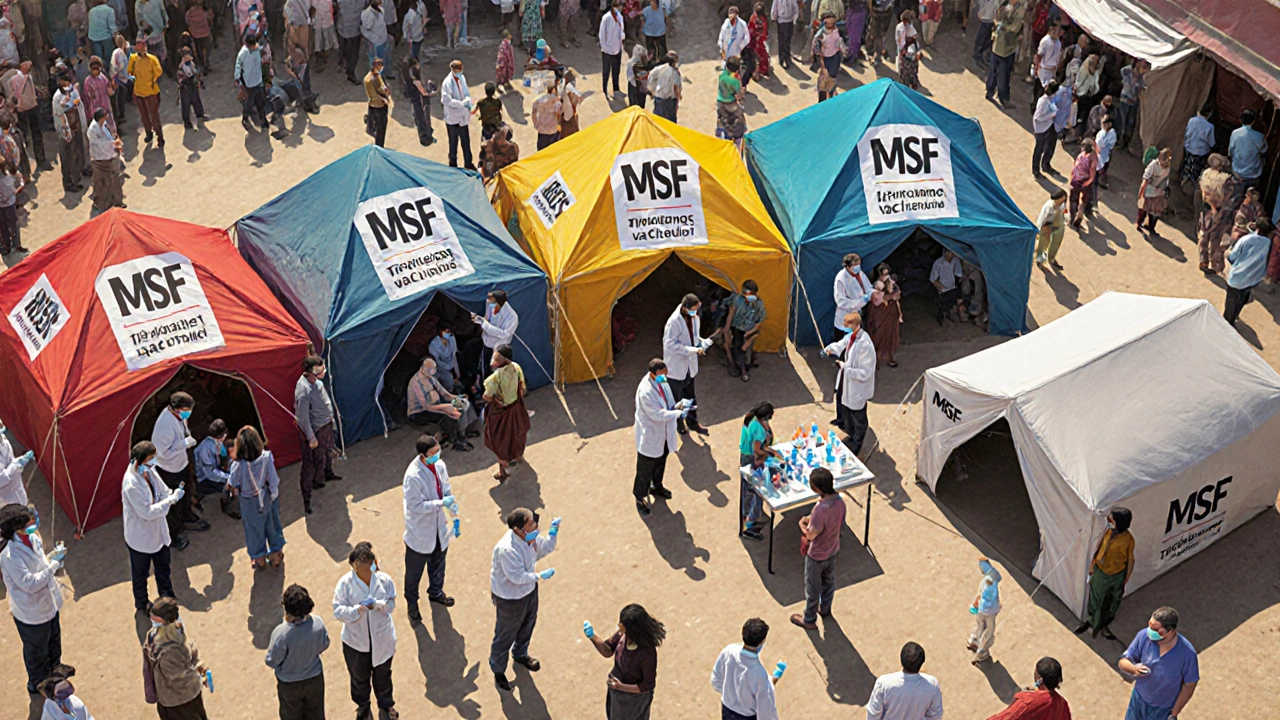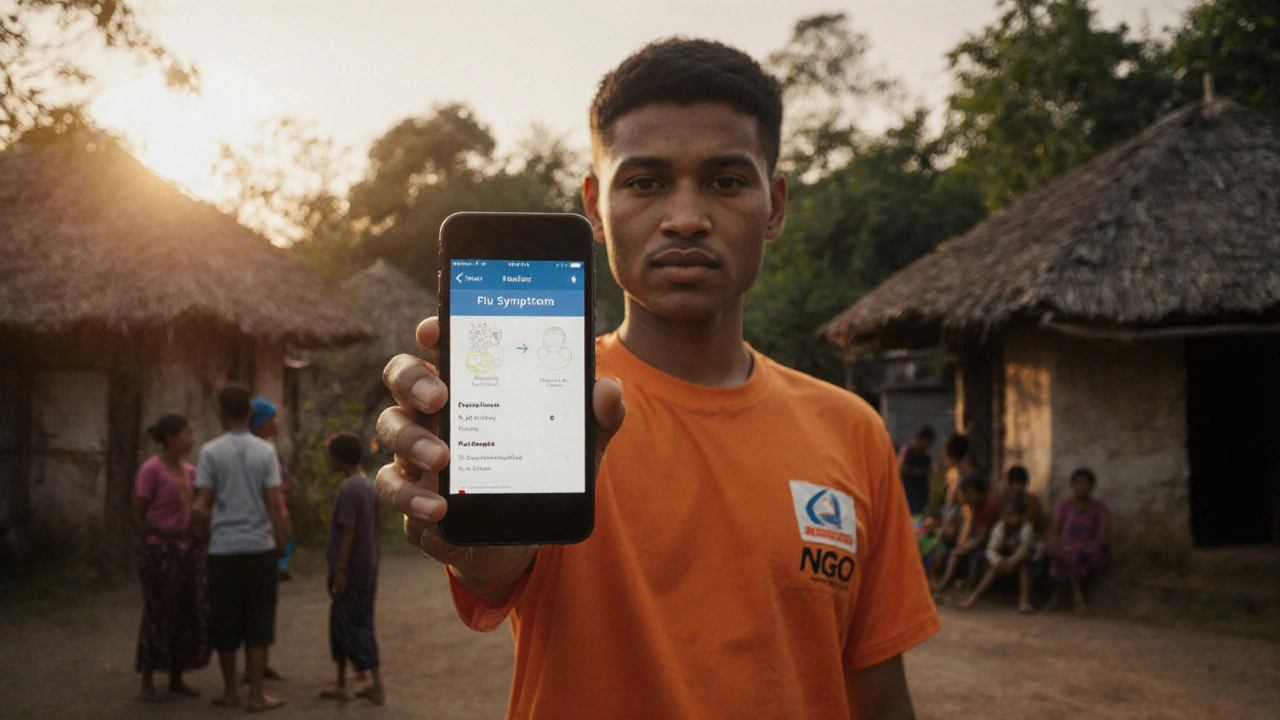Vaccine Distribution Calculator
Calculate Vaccine Requirements
Estimate needed vaccine doses and resources for influenza outbreaks
Results
Enter population and coverage data to see results
Quick Takeaways
- NGOsbridge gaps in surveillance, vaccination, and community education during flu resurgences.
- Successful models combine local outreach with global partnerships (WHO, CDC, GAVI).
- Funding comes from donors, grants, and private‑sector collaborations; sustainability hinges on transparent reporting.
- Key challenges include coordination with governments, data sharing, and rapid scaling of resources.
- Real‑world case studies-Doctors Without Borders, International Federation of Red Cross, and GAVI-show varied but complementary approaches.
When it comes to flu crises, non-governmental organizations often fill the gaps left by governments.
What is re‑emerging influenza?
Influenza is a viral respiratory illness that mutates seasonally. A "re‑emerging" strain describes a virus that resurfaces after a period of low activity, often because of antigenic drift, zoonotic spillover, or waning immunity. The 2023 H5N1‑like outbreak in Southeast Asia illustrated how a bird‑origin virus can quickly jump back into human populations, overwhelming health systems that thought they were out of the flu business.
Unlike the classic seasonal flu, re‑emerging strains may lack a ready‑made vaccine, and their geographic spread can be unpredictable. That uncertainty is precisely where NGOs bring value.
How NGOs fit into the public‑health ecosystem
Non‑governmental organization (NGO) is a independent, non‑profit entity that operates across borders to address social, humanitarian, or health issues. In the flu arena, NGOs act as rapid‑response units, data collectors, and community educators.
Here’s the typical flow:
- Early warning: NGOs run grassroots surveillance that catches unusual spikes before official reports.
- Resource mobilization: They source vaccines, antivirals, and protective equipment through donor networks.
- On‑the‑ground action: Field teams set up vaccination clinics, distribute information leaflets, and train local health workers.
- Feedback loop: Data from clinics are fed back to national health ministries and global bodies like the World Health Organization (WHO), improving the global response.

Core activities of NGOs in flu response
Most NGOs focus on three pillars:
- Surveillance and reporting: Community volunteers use mobile apps to log flu‑like symptoms, creating real‑time heat maps.
- Vaccination campaigns: Partnerships with manufacturers allow NGOs to purchase bulk doses at discounted rates, then deliver them to hard‑to‑reach areas.
- Public education: Culturally tailored messages-often via radio, social media, or local leaders-combat misinformation about vaccine safety.
These actions are reinforced by alliances with the Centers for Disease Control and Prevention (CDC), which provide technical guidelines and lab support.
Funding and partnership models
NGOs rely on a mix of sources:
- Individual donors: Crowdfunding drives for emergency response kits.
- Foundations: Grants from entities such as the Bill & Melinda Gates Foundation fund vaccine procurement.
- Public‑private partnerships: Initiatives like GAVI’s Immunization Supply Chain combine corporate logistics with NGO distribution networks.
Transparent accounting is critical. Most reputable NGOs publish annual financial statements, a practice that encourages continued donor confidence.
Comparison of leading health‑focused NGOs
| NGO | Primary Focus | Geographic Reach | Main Activity in Flu Crises | Primary Funding Source |
|---|---|---|---|---|
| Doctors Without Borders (MSF) | Emergency medical aid | Global, especially low‑resource settings | Rapid field clinics, antiviral distribution | Individual donations, foundation grants |
| International Federation of Red Cross & Red Crescent (IFRC) | Humanitarian relief | Worldwide, strong community networks | Community vaccination drives, health education | Member societies, government contributions |
| GAVI, the Vaccine Alliance | Vaccine access for low‑income countries | 85+ countries, focus on LMICs | Bulk vaccine procurement, supply‑chain management | Public‑private partnership, donor governments |

Success stories: real‑world impact
Case 1 - H5N1 outbreak in Myanmar (2023)
MSF set up three mobile clinics within two weeks, treating over 4,000 suspected cases. Their on‑site lab confirmed the virus, prompting the WHO to issue an international alert. By coordinating with the Myanmar Ministry of Health, MSF helped secure 200,000 vaccine doses, achieving 78% coverage in the most affected districts.
Case 2 - Seasonal flu in rural Kenya (2024)
The IFRC leveraged its community volunteer network to map flu‑like illness using SMS surveys. The data pinpointed an unexpected surge in the Rift Valley region. With GAVI’s vaccine supply, the IFRC organized pop‑up vaccination sites that inoculated 120,000 people in four weeks, cutting hospital admissions by roughly 30%.
These examples illustrate the power of agile, locally rooted NGOs paired with global partners.
Challenges and ways forward
Despite successes, NGOs face recurring obstacles:
- Coordination bottlenecks: Overlapping mandates can cause duplicated effort. A clear liaison desk within ministries helps streamline communications.
- Data sharing restrictions: Confidentiality rules sometimes block rapid exchange of surveillance data. Implementing anonymized dashboards can balance privacy with speed.
- Funding volatility: Emergency appeals spike after a crisis but dwindle during inter‑epidemic periods. Multi‑year grant models provide steadier cash flow.
Future‑proofing involves investing in digital surveillance platforms, strengthening cross‑border training programs, and advocating for policy frameworks that embed NGOs in national pandemic plans.
Frequently Asked Questions
How do NGOs obtain vaccines quickly during an outbreak?
Many NGOs have pre‑negotiated agreements with manufacturers and work through alliances like GAVI. These contracts allow for expedited ordering and reduced shipping times, often within days rather than weeks.
Can NGOs conduct their own influenza surveillance?
Yes. NGOs often train community volunteers to report symptoms via mobile apps or SMS, creating grassroots surveillance networks that complement official data.
What role does the WHO play with NGOs during a flu resurgence?
The WHO provides technical guidelines, validates laboratory results, and coordinates resource allocation. NGOs feed field data back to WHO, which then updates global risk assessments.
How are NGOs funded for long‑term flu preparedness?
Funding comes from a blend of individual donations, foundation grants, and multi‑year contributions from governments and private partners. Some NGOs also generate income through fee‑for‑service training programs.
What are the biggest gaps NGOs still need to close?
Improving data interoperability, securing sustainable financing, and embedding NGOs in national response plans are top priorities. Addressing these gaps will make future influenza responses faster and more coordinated.


Written by Felix Greendale
View all posts by: Felix Greendale